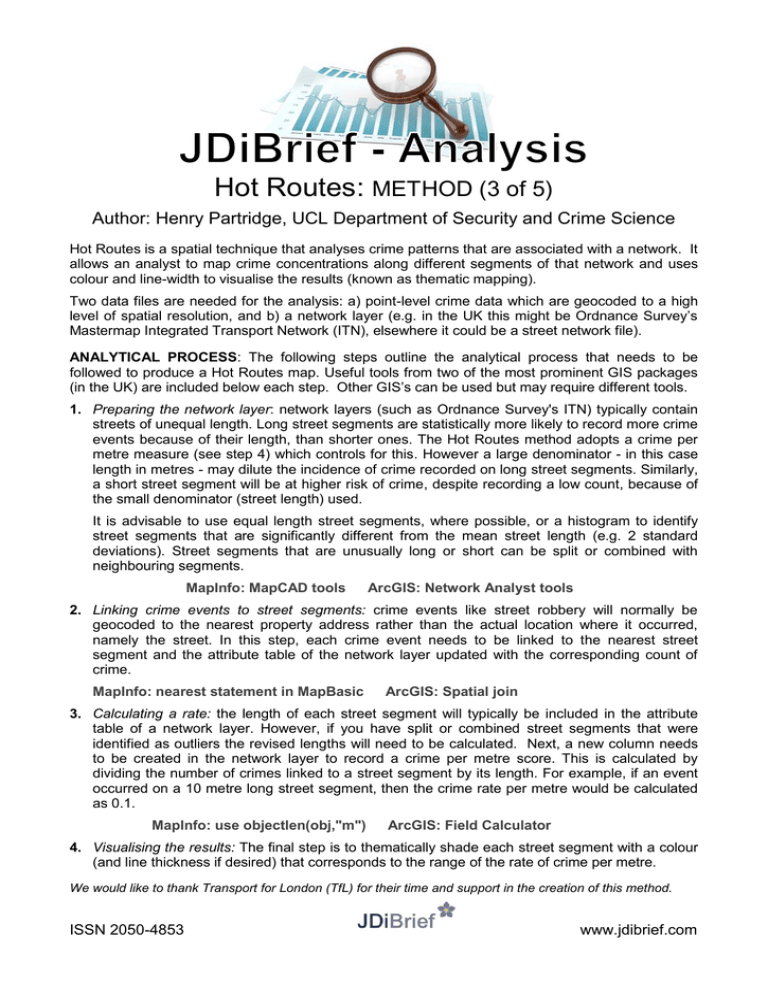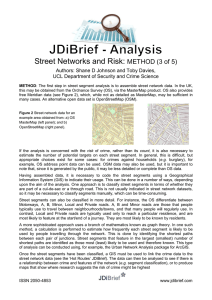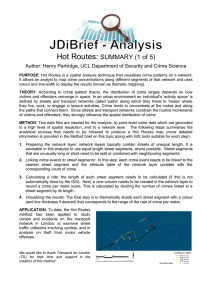Hot Routes: METHOD (3 of 5)
advertisement

Hot Routes: METHOD (3 of 5) Author: Henry Partridge, UCL Department of Security and Crime Science Hot Routes is a spatial technique that analyses crime patterns that are associated with a network. It allows an analyst to map crime concentrations along different segments of that network and uses colour and line-width to visualise the results (known as thematic mapping). Two data files are needed for the analysis: a) point-level crime data which are geocoded to a high level of spatial resolution, and b) a network layer (e.g. in the UK this might be Ordnance Survey’s Mastermap Integrated Transport Network (ITN), elsewhere it could be a street network file). ANALYTICAL PROCESS: The following steps outline the analytical process that needs to be followed to produce a Hot Routes map. Useful tools from two of the most prominent GIS packages (in the UK) are included below each step. Other GIS’s can be used but may require different tools. 1. Preparing the network layer: network layers (such as Ordnance Survey's ITN) typically contain streets of unequal length. Long street segments are statistically more likely to record more crime events because of their length, than shorter ones. The Hot Routes method adopts a crime per metre measure (see step 4) which controls for this. However a large denominator - in this case length in metres - may dilute the incidence of crime recorded on long street segments. Similarly, a short street segment will be at higher risk of crime, despite recording a low count, because of the small denominator (street length) used. It is advisable to use equal length street segments, where possible, or a histogram to identify street segments that are significantly different from the mean street length (e.g. 2 standard deviations). Street segments that are unusually long or short can be split or combined with neighbouring segments. MapInfo: MapCAD tools ArcGIS: Network Analyst tools 2. Linking crime events to street segments: crime events like street robbery will normally be geocoded to the nearest property address rather than the actual location where it occurred, namely the street. In this step, each crime event needs to be linked to the nearest street segment and the attribute table of the network layer updated with the corresponding count of crime. MapInfo: nearest statement in MapBasic ArcGIS: Spatial join 3. Calculating a rate: the length of each street segment will typically be included in the attribute table of a network layer. However, if you have split or combined street segments that were identified as outliers the revised lengths will need to be calculated. Next, a new column needs to be created in the network layer to record a crime per metre score. This is calculated by dividing the number of crimes linked to a street segment by its length. For example, if an event occurred on a 10 metre long street segment, then the crime rate per metre would be calculated as 0.1. MapInfo: use objectlen(obj,"m") ArcGIS: Field Calculator 4. Visualising the results: The final step is to thematically shade each street segment with a colour (and line thickness if desired) that corresponds to the range of the rate of crime per metre. We would like to thank Transport for London (TfL) for their time and support in the creation of this method. ISSN 2050-4853 www.jdibrief.com




